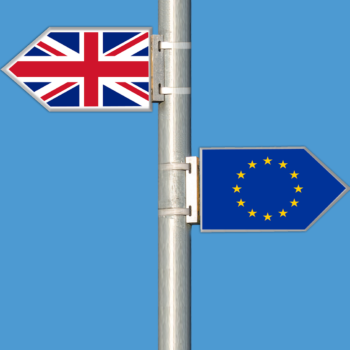5 Parallels Between Brexit & Business Transformation
by Mathew Broughton on 8th Apr 2019 in News

Brexit: the sluggish juggernaut of ongoing news, parliamentary faff, and constant debate. However, there is a general consensus on both sides of the leave/remain argument that something needed to change in terms of the relationship between the UK and the EU.
Digital transformation echos these traits in that businesses are aware that changes need to be made, but are uncertain of how to proceed. In this exclusive piece for ExchangeWire, Shula Sinclair (pictured below), global head of strategy at Spark Foundry explores this analogy further, and what steps can be taken to ensure a successful transition.
Brexit & digital transformation: The analogy
It’s been impossible to escape the ongoing trials and tribulations of Theresa May.
Whether remainers or leavers, no one can deny the Sisyphean nature of the job at hand. Prime Minister May is tasked with transforming the UK’s relationship with the EU. She is doing this with zero consensus amongst her peers, the public and global media on how to deliver this transformation; and that’s just among those who believe that the transformation needs to happen in the first place. Let’s not forget the other half of the country (and rest of world) who believe that nothing should change and that any transformation in the UK’s relationship with the EU would be a catastrophe.

Shula Sinclair, Global Head of Strategy, Spark Foundry
Yes, hindsight is 20:20, but at this pertinent point in time, we can take a view of what May could have done differently over the last 32 months and apply it to that other area of great discussion: Digital Transformation. The parallels between May’s unenviable predicament and bringing about Digital Transformation are just too delicious to ignore, so here are five areas that immediately spring to mind.
If you are one of the anomalies within the marketing community for whom Digital Transformation is not an area of interest, feel free to substitute ‘transform’ with ‘leave’ and ‘brand’ with ‘UK’ and fill in the rest according to your own political convictions.
Make sure that everyone has the same definition of Transformation in mind
Much like ‘leave’, ‘transformation’ means everything and nothing. Define a vision of what transformation means for your company. Ensure it’s an aspiration that galvanises and mobilises your stakeholders and direction of travel is clear. A successful transformation plan begins with the brand’s existing role in consumers’ lives and a vision of the bigger role the brand could play with the right infrastructure in place. A house of fashion brands developing a DTC infrastructure would be doing exactly this, whereas a dairy company investing in a global DMP would possibly not.
Remember that Transformation is a mindset, not a moment
Whether it’s leaving Europe by 11pm on 29 March, or tripling global revenue through an expanded proposition by 2020, you may find your target date creep up on you before you know it, while you are no closer to your desired point of arrival. Come to think of it, since transformation is all about change, there is arguably no point of arrival, because change is constant. Instead, perhaps push for milestones against which you can sense check your progress. Honda is a company that recognises this profoundly, with a clearly defined vision for the entirety of the 21st century with milestones neatly mapped out by decade and at five different levels of operations within the organisation. Once your stakeholders are aligned around your vision, break down and define the milestones that will allow everyone to adopt the right mindset and behaviours and move in the same direction.
Take your people and the benefit of their experience with you
Recognise that any transformation endeavour is about making a leap from an existing foundation. The employees in your company, your agency partners, and your suppliers all contributed to the building of this foundation. So, before you jump, begin with the courtesy of taking a step back. Learn and recognise your stakeholders’ contribution in getting to this point and how their experience can help you accelerate the right kind of change. Understand what of their existing and future contribution must be retained at all costs. For example, in a scenario where growth hinges on the appeal of your brand, and not just your product experience, ensure you are allowing for continued investment in your brand’s appeal and that perhaps the answer isn’t programmatic or WTO terms, for example.
Keep your options open
Transformation requires investment and commitment in tech and platform adoption as well as capability building. However, if by definition the only constant is change, then fluidity and agility need to be factored into your plans. That way, if a tech partner, for instance, elects to withhold log-level data under the guise of GDPR, you are not necessarily backed into a corner and you have before you a number of ways and partners with whom you can develop the work around.
Building wiggle room into your plans ensures you should never find yourself in the position of affecting the change you seek on the proviso of your ultimate resignation.
Begin with the inarguable facts to form your Transformation framework
Digital roadmaps tend to detail how platforms and technology will be integrated into a company’s ecosystem, but rarely expand on how they will build consumer-centricity. Everyone in a company – from procurement to pipeline – has a role to play in the delivery of an enhanced customer experience; so a well thought through consumer journey provides the ideal framework around which to galvanise transformation efforts. Every stakeholder within your organisation is able to see the role they play within that journey and, crucially, where the innovation opportunities lie.
The most successful transformation plans that I have seen have had deep consumer journey (not just purchase journey) understanding at their heart and a vision of how Digital Transformation should elevate it. This shared understanding then sparks conversations on how to collaborate and join up around the journey, rather than how to carve up fiefdoms or initiate votes of no confidence.
Digital MarketingIndustry InfrastructureTechnology








Follow ExchangeWire